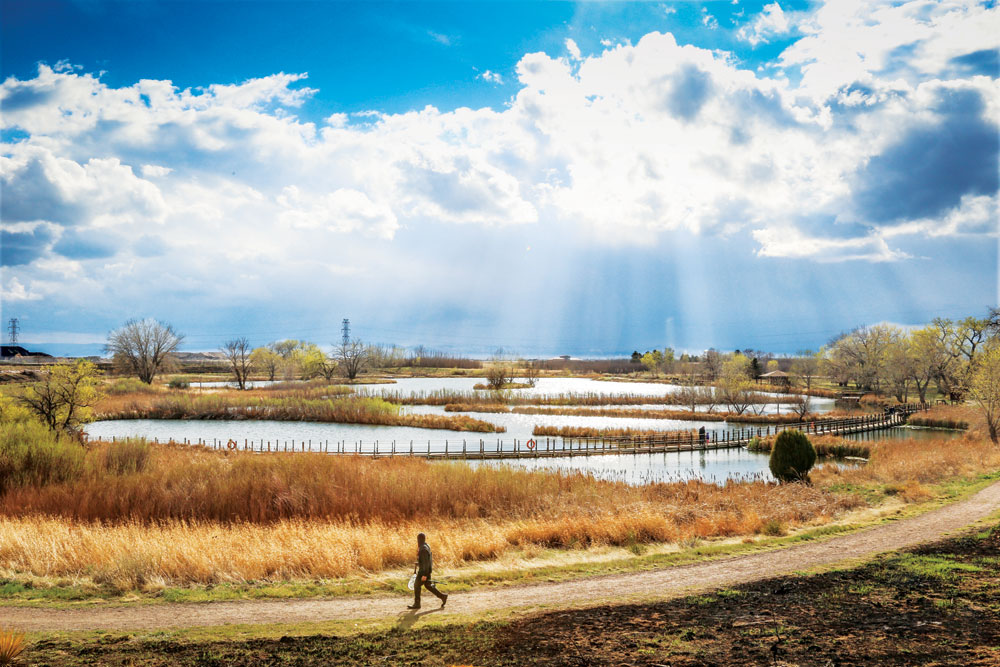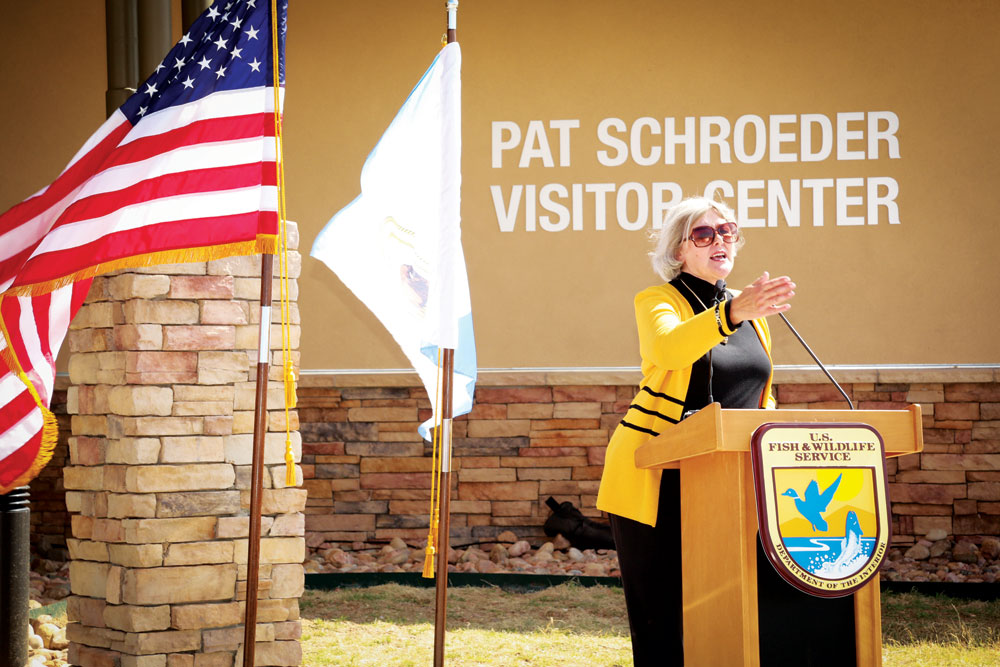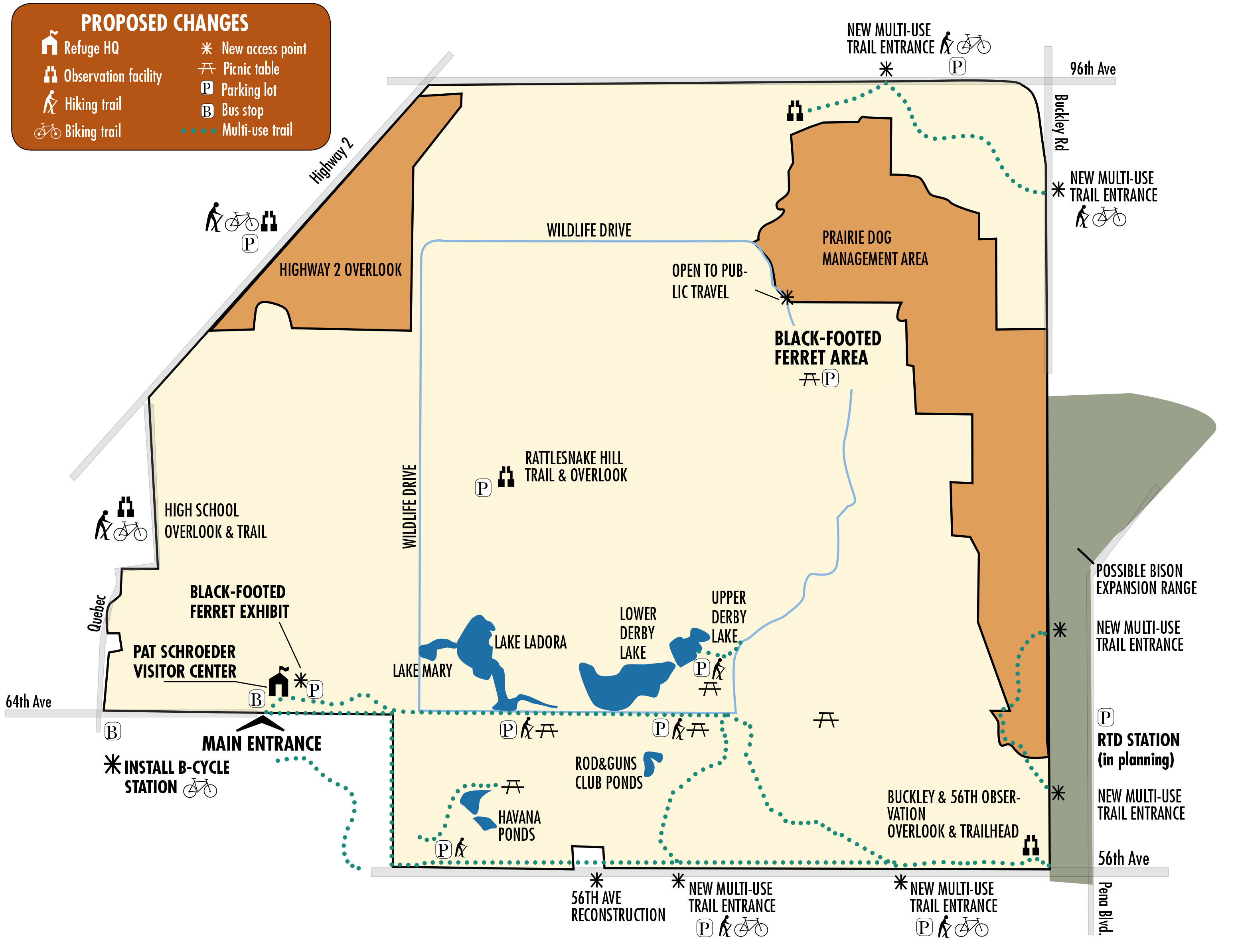
The Rocky Mountain Arsenal National Wildlife Refuge unveiled a plan for the next 15 years that will reintroduce native species, add amenities and allow more public use, including bikes. After 15 years transitioning from a wartime manufacturing site, the refuge is excited to emerge as the “single best place in the U.S. to connect millions of Americans with conservation,” says refuge manager David Lucas.
The U.S. Fish and Wildlife Service announced in April a 15-year plan for the Rocky Mountain Arsenal National Wildlife Refuge. The plan aims to make the refuge more accessible to the public and restore a more natural prairie ecosystem by reintroducing native species. “This is a pretty important moment in time for the refuge. Now that cleanup is over, we’re really developing a plan for how we’re going to manage the refuge into the future. It’s been a lot of fun,” says David Lucas, refuge manager. He is a planning for a boom in visitation.
Fifteen years ago, this land wasn’t even inhabitable. Until 1950, the U.S. Army used the site to make and store nerve gases, mustard gas and other deadly chemical weapons. Here, too, Shell Oil made dieldrin, aldrin and other toxic pesticides. After the production shut down, the land sat unused and remained highly contaminated. “I would fly over the arsenal and thought, what in the world is there?” says former Colorado Congresswoman Pat Schroeder remembering when she moved to Denver in 1964. She made inquiries, but the site was deemed classified information. When Schroeder was elected to the Armed Services Committee in 1972, she demanded to know what was going on at the site. “They told me it was nerve gas and I thought that was so scary,” she said.
Schroeder visited the area and was shocked by the amount of dead wildlife. “They gave me this big, long report that said if you were exposed to it, it didn’t make your hair fall out, it didn’t make you lose your hearing, and overall there were no side effects … except death. So typical military,” she says. She knew the land needed to be saved. In 1996, a 14-year $2 billion cleanup effort was launched. Cleanup was completed in 2010 and now the site is home to more than 330 species of animals, including deer, coyotes, prairie dogs and burrowing owls. Eighty cinnamon-colored genetically pure bison roam the site. During winter, nearly 80 bald eagles can be seen.

Former U.S. Congresswoman Pat Schroeder speaks at a ceremony at the refuge to name the visitor center after her in honor of her efforts to get the site cleaned up.
The site is used to educate about the impact of humans on wildlife and celebrate conservation. “Whether it’s climate change, invasive species or habitat fragmentation, we’ve figured out our only way to conserve wildlife into the future is to figure out how to connect millions of Americans with this conservation and make them care,” David Lucas says. A wildlife fanatic who knew he wanted to work for the Department of Interior by age 10, Lucas is all enthusiasm while talking about the future of the arsenal (click here to watch a video produced by the U.S. Fish & Wildlife Service featuring David Lucas on the importance of conservation).
Currently, 300,000 people visit the refuge every year—unacceptably low considering all the families in abutting neighborhoods, according to David Lucas. Many people don’t even know the refuge exists and some have complained it is uninviting. For example, a person from Montbello has to travel 12 miles to enter the main gate. With proposed changes to make it more accessible, Lucas expects 1 million visitors a year. The plan adds more parking lots and non-motorized entrances; meaning, bikes will be allowed. A person will be able to bike all the way from Stapleton to the refuge by way of the Westerly Creek Trail. Trails within the refuge have been designed to have the least possible impact on wildlife. See the map below.
(to download a printable version of the map above click here)
The plan designates an area of the refuge for hunting deer and dove. Only archery will be allowed, and youth and the disabled will be the only people eligible. All hunting would take place in areas closed to the general public, thus minimizing both sound and safety concerns to visitors and surrounding neighbors. A 1,000-foot safety buffer around the Refuge perimeter would be established to minimize potential impacts or conflicts with activities outside Refuge lands. Additionally, a 500-foot safety buffer would be established around all public use Refuge roads, minimizing conflicts with other visitors.
The plan also reintroduces native species, including prairie chickens, plains sharp-tailed grouse, and the black-footed ferret, the most endangered mammal in the U.S. Black-footed ferrets survive off of prairie dogs—a male eats 100 a year and a female 150. By reintroducing the top of the food chain, a phenomenon called trophic cascade, ecosystems function more naturally, says Lucas. The best example is the reintroduction of wolves in Yellowstone National Park that changed the behavior of elk. The refuge will add a black-footed ferret exhibit at the visitor center, which in April was aptly named the Pat Schroeder Visitor Center.

The black-footed ferret is the most endangered mammal in the U.S. and is proposed to be introduced at the arsenal in 2015. The ferrets eat prairie dogs and will help control those populations. (Photo provided by U.S. Fish & Wildlife Service)
To make all these changes possible, the plan proposes more staffing and funding to expand educational programs about conservation. “My big thing is, it’s a new chapter, man. It’s time for folks to recognize this place is cool, it’s amazing, it’s here, it’s open. We want people to come and experience nature here. And to us, that’s our big goal over the next 15 years.” The Fish and Wildlife Service is embarking on a 60-day review of the proposed plan. They will have four meetings soliciting public questions and comments. Check the refuge website for meeting dates at www.fws.gov/refuge/rocky_mountain_arsenal.



3803 I-80 Service Rd.
Interested in future plans and a good time or month to come visit the RMA. Thank you.
How long is the loop to drive ?
For information about Rocky Mountain Arsenal National Wildlife Refuge, call the Visitor Center at 303-289-0930.
Are horses allowed?
No, unfortunately horses will not be allowed because the terrain is not right, according to the refuge manager. Horseback riding is already allowed on the trail around the perimeter of the refuge though.. and horses are included in the Master Revision Plan for Rocky Flats National Wildlife Refuge, if you ever make it there.